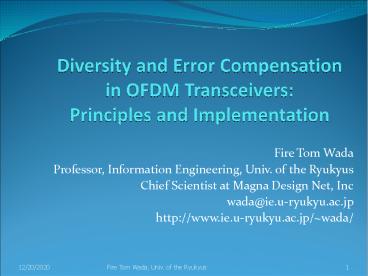Diversity and Error Compensation in OFDM Transceivers: Principles and Implementation
Title:
Diversity and Error Compensation in OFDM Transceivers: Principles and Implementation
Description:
Fire Tom Wada Professor, Information Engineering, Univ. of the Ryukyus Chief Scientist at Magna Design Net, Inc wada_at_ie.u-ryukyu.ac.jp http://www.ie.u-ryukyu.ac.jp/~wada/ –
Number of Views:139
Avg rating:3.0/5.0
Title: Diversity and Error Compensation in OFDM Transceivers: Principles and Implementation
1
Diversity and Error Compensation in OFDM
Transceivers Principles and Implementation
- Fire Tom Wada
- Professor, Information Engineering, Univ. of the
Ryukyus - Chief Scientist at Magna Design Net, Inc
- wada_at_ie.u-ryukyu.ac.jp
- http//www.ie.u-ryukyu.ac.jp/wada/
2
Section 1
- OFDM transceivers Principles and design
3
18.2.1Single Carrier vs. Multi Carrier
4
18.2.2OFDM signal generation (1)
- Orthogonal relations
- One subcarrier signal
- Baseband OFDM signal
- Complex baseband OFDM signal
5
OFDM signal generation (2)
- Sampled by N points
- Passband signal
6
OFDM Transmitter Block Diagram
7
18.2.3 OFDM signal reception (1)
- Passband signal
- Direct down conversion
- Applying the low pass filter
- Another direct conversion
8
OFDM signal reception (2)
- Combining SI(t) and SQ(t)
- Sampling
- IDFT operation
- DFT operation
9
Simple OFDM Receiver Block Diagram
10
18.2.4Multipath channel
11
Guard Interval
12
18.2.5 Channel Estimation and Equalizer
- Reception signal sR(t)
- CTF
- Frequency domain
- Equalization
13
18.2.6OFDM communication and broadcasting systems
14
Synchronization
- Radio frequency (RF) synchronization
- Sampling rate synchronization
- Symbol timing (FFT window position)
synchronization
15
OFDM communication and broadcasting system
16
18.2.7OFDM WLAN design
17
WLAN frame format and receiver tasks
18
WLAN Block Diagram
19
18.2.8OFDMA transceiver design
20
TDD Frame and GAP
21
simplified OFDMA and SC-FDMA
22
Base Station TX and RX
23
User Terminal TX and RX
24
Section 3
- Error Detection and Compensation
25
18.4.1 Time domain RF error detection and
compensation
26
Time domain RF error compensation feedback
27
18.4.2 Time domain FFT window position detection
and RF error detection
28
18.4.3 Time domain RF error, sampling error, and
symbol timing detection and compensation
29
Time domain RF error and sampling clock error
compensation
30
18.4.4 Frequency domain RF error and sampling
error detection
31
Frequency domain RF error and sampling error
detection (2)
32
18.4.5 Delay profile detection and frequency
domain FFT position detection
33
18.4.6 FFT window shift detection by
constellation rotation and compensation
34
Section 4
- Hardware Implementation and System Integration
35
18.5.1 Four antenna adaptive array combiner LSI
36
Four antenna adaptive array combiner LSI (2)
37
18.5.2 A 2/4/8 Antennas Configurable Diversity
OFDM Receiver LSI
38
A 2/4/8 Antennas Configurable Diversity OFDM
Receiver LSI (2)
39
18.5.3 Joint Hardware-Software Implementation of
Adaptive array antenna OFDM receiver by FPGA
40
Joint Hardware-Software Implementation of
Adaptive array antenna OFDM receiver by FPGA (2)
41
Joint Hardware-Software Implementation of
Adaptive array antenna OFDM receiver by FPGA (3)
42
3.2.4 Hybrid Pre-FFT Adaptive Array Antenna and
Post-FFT Space Diversity Combining for Mobile
ISDB-T Receiver by FPGA
43
System configurations A and B
44
Hybrid Pre-FFT Adaptive Array Antenna and
Post-FFT Space Diversity Combining for Mobile
ISDB-T Receiver by FPGA (3)
45
Conclusion
- In section 1
- Basic OFDM equations are reviewed
- 3 key synchronization
- Architecture examples
- In section 3
- Synchronization error detection and compensations
- Time domain Frequency domain
- In section 4, Some real design examples































